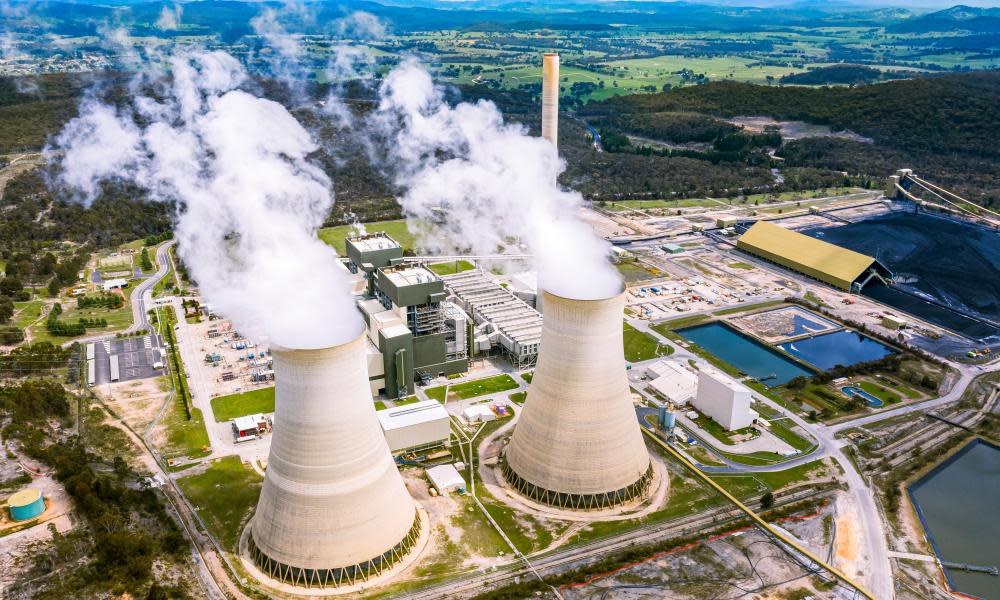NSW ‘almost ready to sign up’ to coal price cap to provide energy price relief

New South Wales is prepared to agree to a price cap on coal without compensation to provide energy price relief to consumers and business, adding pressure on Queensland to follow suit.
Meanwhile, a meeting of energy ministers in Brisbane on Thursday has agreed, as expected, to move ahead with a so-called capacity investment scheme to help accelerate the take up of new storage in the electricity grid.
NSW’s treasurer and energy minister, Matt Kean, told reporters in Brisbane on Thursday that his state was “almost ready to sign up” to limiting the price of black coal, which in turn sets wholesale electricity prices in the state about half the time.
Related: Federal Labor prepared to compensate states in effort to drive down energy bills
“It’s not about royalties, it’s all about consumers,” Kean told reporters as he arrived for a five-hour meeting of federal, state and energy ministers, in comments broadcast by Sky News. “NSW is prepared to take the hit” by not seeking compensation.
However, after the ministers’ meeting, Kean told a media conference that while “NSW did not need compensation for lost coal royalties as a result of the coal cap … we did ask for financial assistance to support families and businesses as a result of us doing what we need to do to support our country to lowering energy prices”.
Guardian Australia understands the coal price cap being discussed remains at $125 a tonne. For gas, the limit being negotiated between governments is between $12 and $14 a gigajoule.
The Queensland government expects to face increased pressure to accept gas and coal price caps with reduced compensation if NSW unilaterally signs on to the federal plan.
A spokesperson for federal energy minister, Chris Bowen, who arrived at the ministerial conference with Kean, declined to comment.
The energy ministers’ meeting itself was not focused on the price cap debate, given the final decisions will be made between the prime minister, Anthony Albanese, and his state and territory counterparts at a meeting planned for Friday. That meeting was to have been held yesterday before Albanese contracted Covid, prompting a two-day delay.
Energy prices have become an increasingly fraught issue for governments and also contributed to Australia’s highest inflation rate since 1990.
Related: Snowy Hydro promises Clough Group’s collapse won’t disrupt multibillion-dollar project
Australia’s abundance of energy resources has not shielded it from a global surge in energy costs in the wake of Russia’s invasion of Ukraine 10 months ago. Western Australia, however, is the exception where a 15% share of gas output is reserved for local consumers, leaving prices as low as a quarter of those being endured in the east.
The energy ministers, meanwhile, have been working through an agenda that included approval of plans for a mechanism to drive more investment into large-scale batteries and other forms of storage.
A statement from Bowen’s office said the capacity investment scheme would provide a “national framework needed to drive new renewable dispatchable capacity and ensure reliability in Australia’s rapidly changing energy market over the next decade and beyond”.
“This new revenue underwriting mechanism will unlock around $10bn of investment in clean dispatchable power to support reliability and security as the energy market undergoes its biggest transformation since the industrial revolution”, the statement said. “It is more necessary that ever in these challenging times.”
The government will open tenders to determine which projects gain CIS support to help decrease risk for investors and spur more investment. The Australian Energy Market Operator would hold auctions in each jurisdiction.
It will set an agreed revenue “floor” to help cover project operating costs and debt repayments, with the government covering the difference when revenues fall short. Profits will be shared whenever revenues exceed an agreed “ceiling” price.
Key to securing support from the states and territories is ensuring that the scheme could complement their own programs. Victoria and the ACT, in particular, have insisted that any capacity mechanism would be restricted to zero emissions technology and not used to extend the operating lives of coal and gas-fired plants.
The government will release further details on the scheme in the coming months, with a view to the first auction occurring in 2023, Bowen’s office said.
Groups like the Smart Energy Council have applauded the results as finally delivering a national plan for renewable energy generation and storage.
“That means cheaper, cleaner and more reliable power for all Australians,” the council’s CEO, John Grimes, said. He called on governments to turn their gaze now to small-scale schemes that rollout batteries for homes – much like a similar program accelerated the take-up of roof-top solar panels that now dot about one-third of Australian homes.
Likewise, Kane Thornton, CEO of the Clean Energy Council, hailed today’s approval as likely to “unlock the next wave of renewable energy projects”.
“Energy storage will play a crucial role in supporting the massive amounts of new wind and solar needed for the future,” Thornton said. “While measures to accelerate storage rollout are important, we also need to develop the markets and technical frameworks that will enable stable, long-term investment in storage.”
Ministers also agreed to advance work on a National Renewable Energy Supply Chain Action Plan that will create job opportunities in manufacturing. It is to be developed by the end of 2023, and will be led by Queensland energy minister Mick de Brenni.

 Yahoo Movies
Yahoo Movies 
